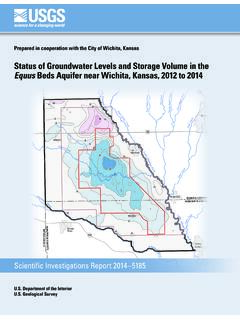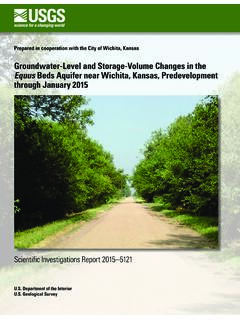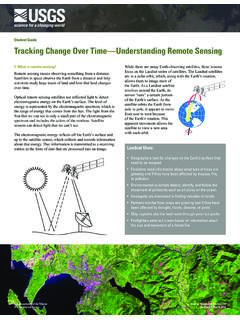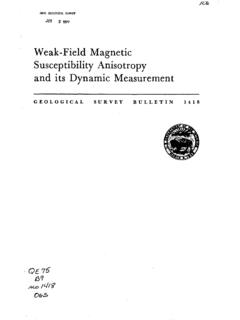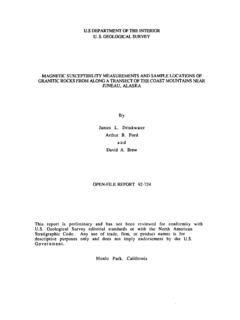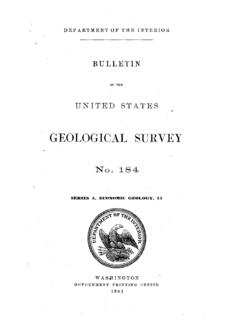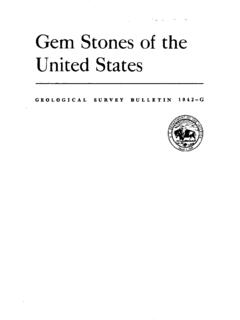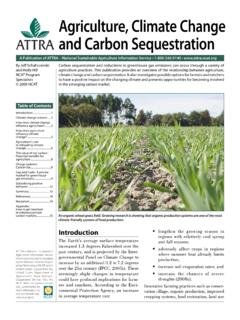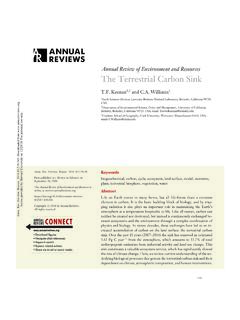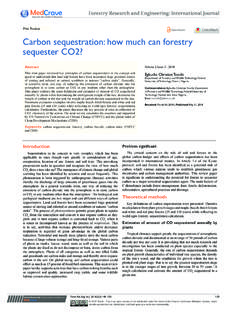Transcription of Fundamentals of Carbon Dioxide-Enhanced Oil Recovery …
1 Fundamentals of Carbon Dioxide-Enhanced Oil Recovery (CO2-EOR) A Supporting Document of the Assessment Methodology for Hydrocarbon Recovery Using CO2-EOR Associated with Carbon sequestration By Mahendra K. Verma Open-File Report 2015 1071 Department of the Interior Geological Survey ii Department of the Interior SALLY JEWELL, Secretary Geological Survey Suzette M. Kimball, Acting Director Geological Survey, Reston, Virginia: 2015 For more information on the USGS the Federal source for science about the Earth, its natural and living resources, natural hazards, and the environment visit or call 1 888 ASK USGS (1 888 275 8747).
2 For an overview of USGS information products, including maps, imagery, and publications, visit Any use of trade, firm, or product names is for descriptive purposes only and does not imply endorsement by the Government. Although this information product, for the most part, is in the public domain, it also may contain copyrighted materials as noted in the text. Permission to reproduce copyrighted items must be secured from the copyright owner. Suggested citation: Verma, , 2015, Fundamentals of Carbon Dioxide-Enhanced oil Recovery (CO2-EOR) A supporting document of the assessment methodology for hydrocarbon Recovery using CO2-EOR associated with Carbon sequestration : Geological Survey Open-File Report 2015 1071, 19 p.
3 , ISSN 2331-1258 (online) iii Contents Introduction .. 1 Background .. 1 Objective .. 1 CO2-Enhanced Oil Recovery (EOR) Process .. 2 General .. 2 Geologic Framework .. 3 Significance of Variables .. 3 Reservoir Engineering Aspect .. 3 Properties of CO2 .. 5 Fundamentals of the CO2-EOR Process .. 5 CO2 Flood/Injection Designs .. 9 Oil Recovery Factor or Efficiency .. 12 CO2-EOR Process Performance Evaluation and Simulation .. 12 Operational Aspect .. 14 CO2 Source .. 14 Surface Facilities .. 14 CO2-EOR and the World .. 14 Technological Challenges .. 15 Residual Oil Zone (ROZ)/Transition Zone (TZ).
4 15 Next Generation CO2-EOR Technology .. 15 Conclusions .. 16 References Cited .. 16 Figures 1. Plot showing oil production in barrels per day associated with various enhanced oil Recovery (EOR) methods .. 5 2. Slim-tube oil recoveries at increasing pressures for fixed oil composition and temperatures .. 6 3. The schematic of the CO2 ( Carbon dioxide) miscible process showing the transition zone between the injection and production well .. 7 4. Minimum miscibility pressure (MMP) correlation with molecular weight (MW) of C5+ components and reservoir temperature .. 8 5. Lasater (1958) correlation relating the molecular weight of C5+ components with oil gravity.
5 8 6. Solubility of Carbon dioxide (CO2) in Day crude oil (from Moran field in Kansas) as a function of pressure and temperature .. 9 7. Schematic of various Carbon dioxide (CO2) flood-injectant designs in oil reservoirs .. 11 8. A typical plot of incremental oil Recovery with Carbon dioxide (CO2)- enhanced oil Recovery and the injection volume (CO2 + H2O [water]) .. 13 Table 1. Summary of Carbon dioxide projects within the United States .. 4 iv Conversion Factors Inch/Pound to SI Multiply By To obtain Length foot (ft) meter (m) mile (mi) kilometer (km) Area acre 4,047 square meter (m2) acre hectare (ha) acre square hectometer (hm2) acre square kilometer (km2) square inch (in2) square centimeter (cm2) Volume barrel (bbl), (petroleum, 1 barrel=42 gal) cubic meter (m3) acre-foot (acre-ft) 1,233 cubic meter (m3) acre-foot (acre-ft) cubic hectometer (hm3) Flow rate gallon per day (gal/d) cubic meter per day (m3/d) Mass pound, avoirdupois (lb) kilogram (kg)
6 Pressure pound per square inch (lb/in2) kilopascal (kPa) Temperature in degrees Celsius ( C) may be converted to degrees Fahrenheit ( F) as follows: F=( C)+32 Temperature in degrees Fahrenheit ( F) may be converted to degrees Celsius ( C) as follows: C=( F-32) v Abbreviations API American Petroleum Institute CO2 Carbon dioxide EOR enhanced oil Recovery EPA Environmental Protection Agency EISA Energy Independence and Security Act of 2007 HCPV hydrocarbon pore volume MMP minimum miscibility pressure OOIP original oil-in-place ROZ residual oil zone TDS total dissolved solids TZ transition zone USGS Geological Survey WAG water-alternating-gas Fundamentals of Carbon Dioxide-Enhanced Oil Recovery (CO2-EOR)
7 A Supporting Document of the Assessment Methodology for Hydrocarbon Recovery Using CO2-EOR Associated with Carbon sequestration By Mahendra K. Verma Introduction Background Under the Energy Independence and Security Act of 2007 (EISA; Congress, 2007, Public Law 110 140) legislation, the Geological Survey (USGS) developed a probability-based methodology to assess the Nation s technically accessible geologic storage resources available for sequestration of Carbon dioxide (CO2) (Brennan and others, 2010; Blondes and others, 2013), independent of economic constraints. With the completion of the assessment of CO2 geologic storage resources using the above methodology ( Geological Survey Geologic Carbon Dioxide Storage Resources Assessment Team, 2013a,b,c), the first part of the USGS s commitment of the EISA legislation was fulfilled.
8 The second part of the USGS commitment under the EISA legislation is to assess the hydrocarbon Recovery potential in oil and gas fields within the sedimentary basins of the United States using CO2-enhanced oil Recovery (CO2-EOR) methods. Higher primary recoveries in excess of 70 percent in gas reservoirs (Comelson, 1974; Alejandro and Lopez, 2000) and the cost of additional facilities required for CO2 injection make the CO2-EOR process economically unattractive, and as a result, there has been no reported attempt to consider application of tertiary Recovery in gas reservoirs.
9 Therefore, only oil reservoirs will be included in the assessment, and gas reservoirs will not be discussed here. Equivalent to the recoverable oil volume or the total oil produced is the reservoir pore space available for sequestration (storage) of industrial Carbon dioxide. Objective The objective of this report is to provide basic technical information regarding the CO2-EOR process, which is at the core of the assessment methodology, to estimate the technically recoverable oil within the fields of the identified sedimentary basins of the United States. Emphasis is on CO2-EOR because this is currently one technology being considered as an ultimate long-term geologic storage solution for CO2 owing to its economic profitability from incremental oil production offsetting the cost of Carbon sequestration .
10 2 CO2-Enhanced Oil Recovery (EOR) Process General After discovery, an oilfield is initially developed and produced using primary Recovery mechanisms in which natural reservoir energy expansion of dissolved gases, change in rock volume, gravity, and aquifer influx drive the hydrocarbon fluids from the reservoir to the wellbores as pressure declines with fluid (oil, water, or gas) production. Primary oil recoveries range between 5 and 20 percent (Stalkup, 1984) of the original oil-in-place (OOIP). These low recoveries prompt field operators to find ways to improve Recovery through the application of secondary Recovery methods, which provide additional energy to the reservoir.
